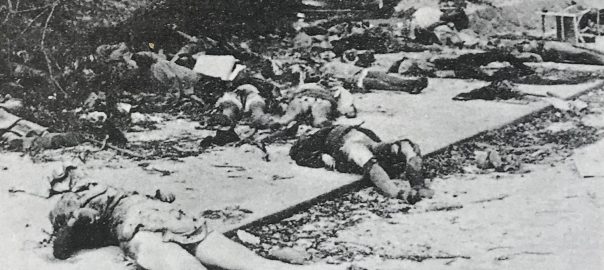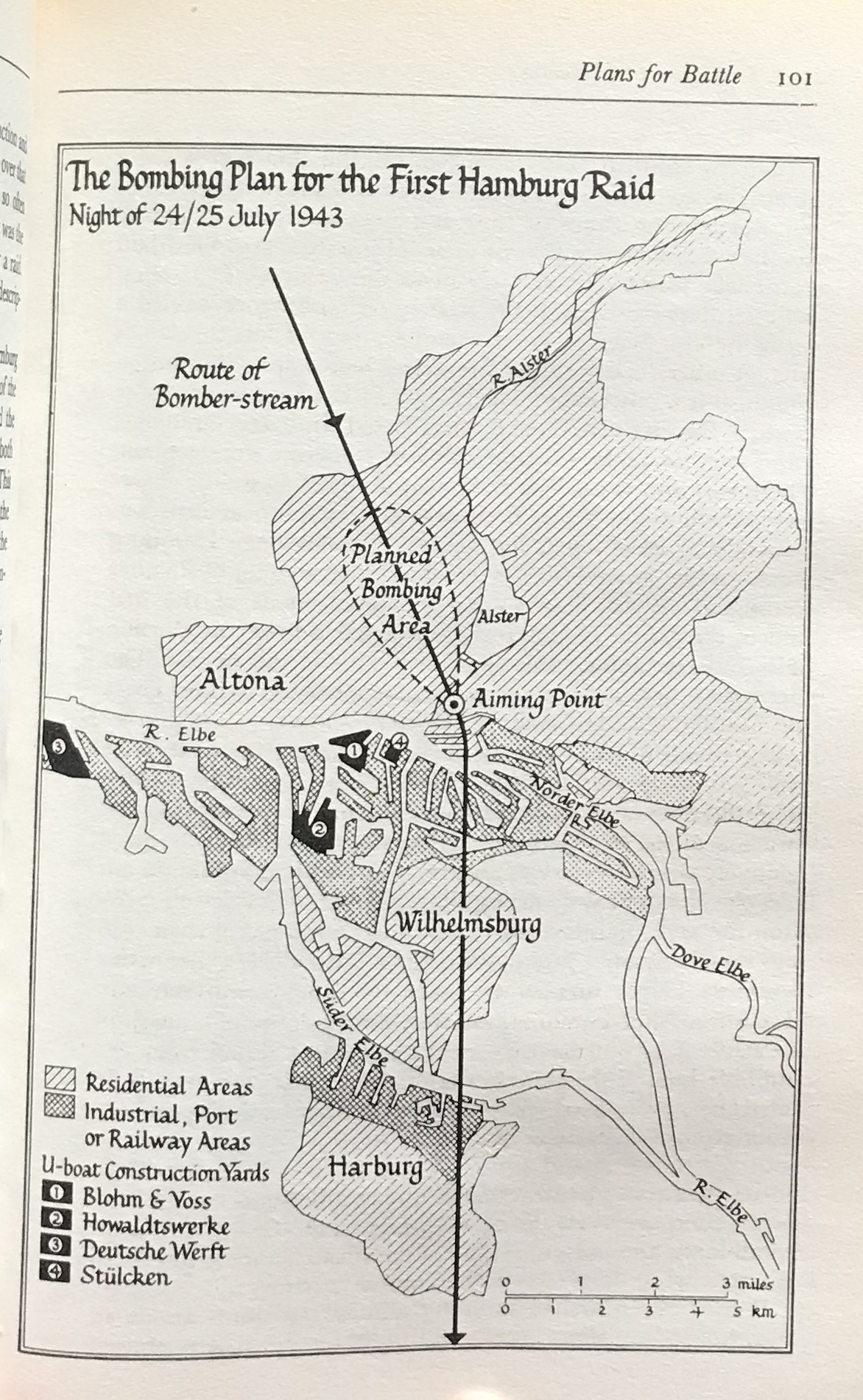The image above shows some of the victims of the RAF’s “Battle of Hamburg”
As we know, when U.S. Pres. Harry Truman and his advisors decided on the first-ever use of an atomic bomb, in early August 1945, they were well aware that the main victims of this explosion would be the large civilian population of Hiroshima. The bomb was set to explode some 600 feet above the city, to maximize the spread of its explosive, radiation, and thermal effects over the whole city. No attempt was made to “target” those parts of the city dedicated to war-related industries or other preparations for war-making.
This deliberate choice of bombing entire urban areas, known as “Area Bombing”, had also been used by the U.S. Air Force in the repeated firebombings of entire cities it had undertaken throughout Japan over the preceding few months.
But when did Western’ militaries and their civilian leaders decide that it was okay– indeed, desirable– to bomb entire city populations? This approach, after all, directly flouted all the preceding decades of insistence that the only “legitimate” targets in warfare were either (a) the opposing armies/navies or, possibly (b), facilities directly dedicated to the preparation or organizing of war. (These restrictions on what constituted a “legitimate” target were later to be codified in the Geneva Conventions of 1949. Violating them is clearly recognized as a war crime.)
The key decision that large, civilian-occupied urban areas should be considered actual targets in themselves was not taken by the U.S. leadership in 1945. It was taken more than three years earlier, in a key directive that the British Air Ministry sent to the RAF’s Bomber Command in February 1942. It stated that,
the primary object of your operations should now be focussed on the morale of the enemy civilian population and, in particular, of the industrial workers.
Cited in M. Middlebrook, ‘The Battle of Hamburg’ (1980), p.24
I found that reference in Martin Middlebrook’s 1980 book The Battle of Hamburg. The whole of the page in which he describes the February 1942 decision is worth reading:
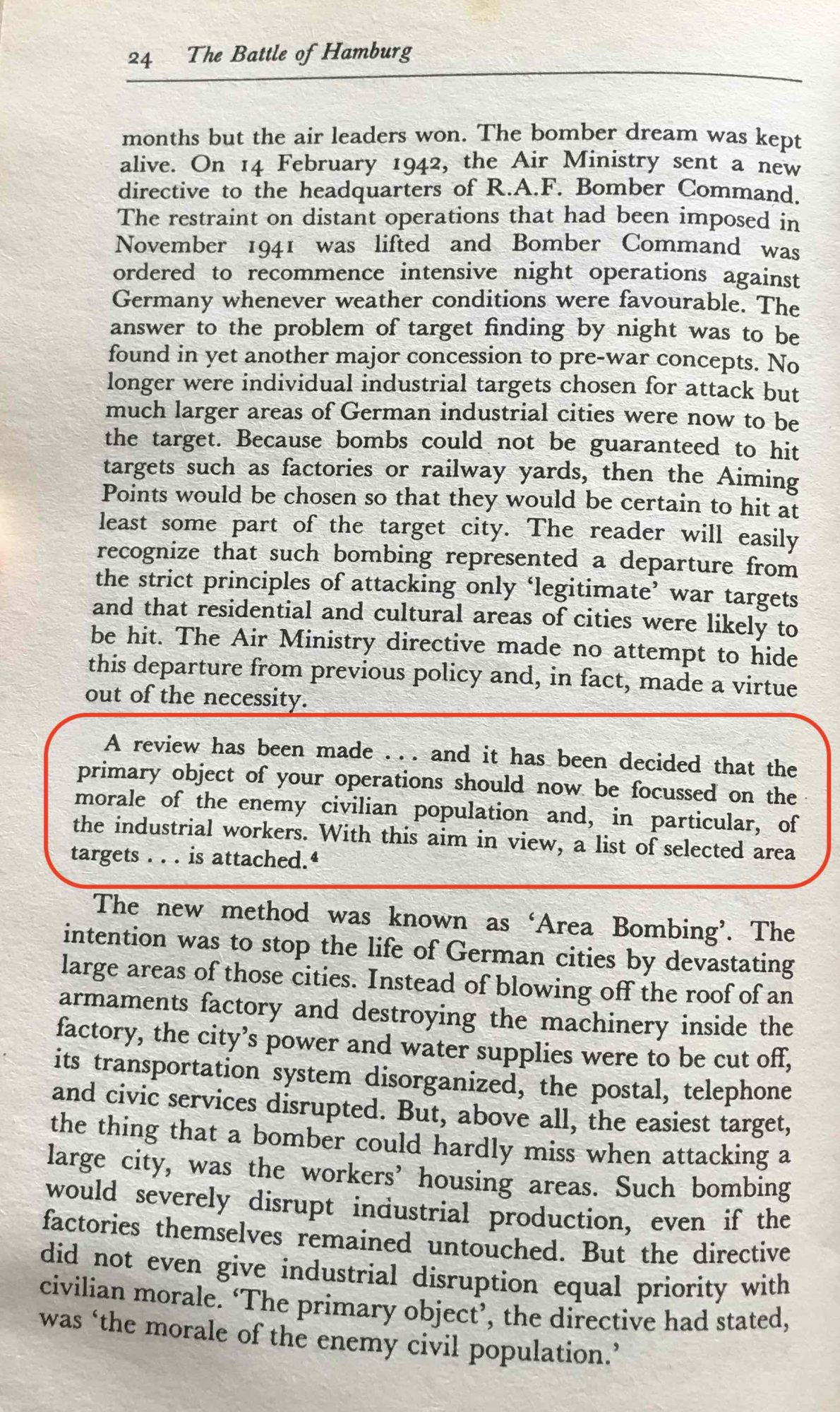
There is another good description of the context and effects of this British decision in pp.246 and 247 of Daniel Ellsberg’s 2017 book, The Doomsday Machine:
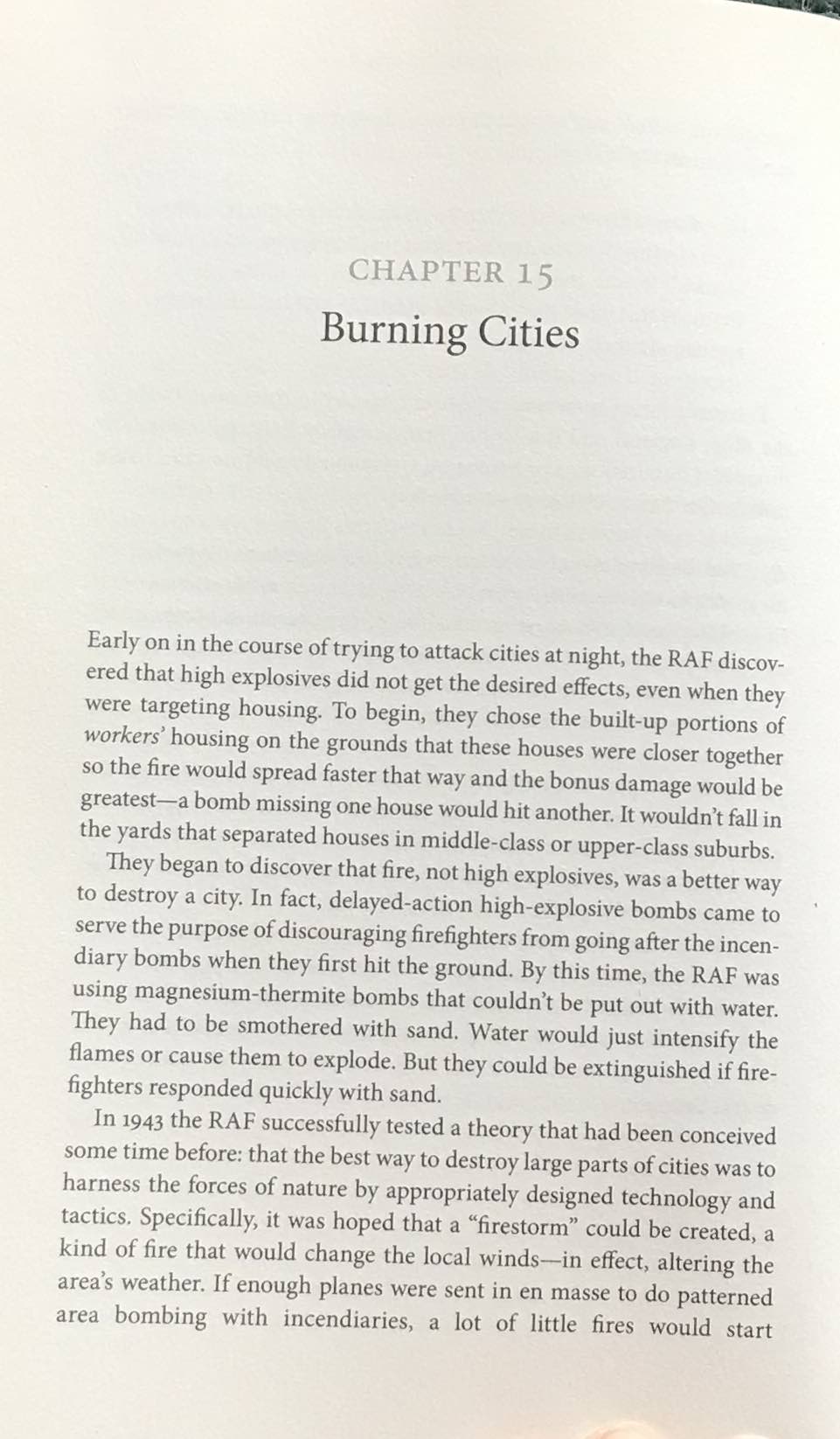
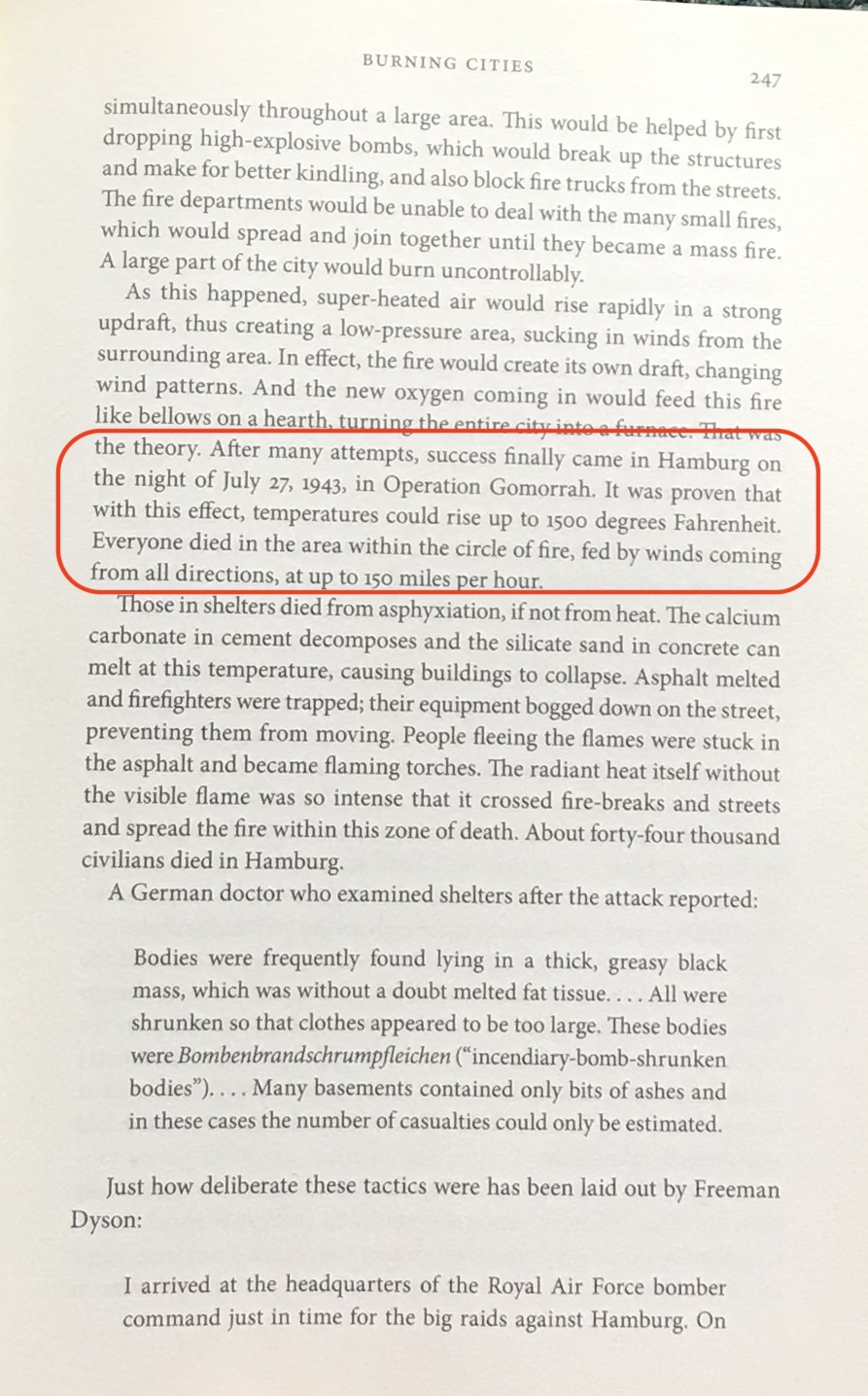
I had briefly discussed this important finding by Ellsberg, in this recent short “Reel” that I made on Just World Ed’s Instagram account. But now I’ve been reading Middlebrook’s very detailed study of the “Battle of Hamburg”, which was the first major campaign that embodied the Bomber Command’s new focus on bombing civilian areas and the first real “success” (as noted by Ellsberg) in its attempt to kill people by creating intense firestorms.
Bomber Command carried out the Battle of Hamburg (aka, “Operation Gomorrah”) through four massed, night-time bombing raids carried out over ten nights in late July – early August, 1943. Here’s the map Middlebrook provides for the planned drop zone for the first raid:
As you can see, the stream of hundreds of bombers, coming in from the north, were expected to drop their bombs (both regular, large explosive bombs and many sticks of incendiary bombs) over an area of the city that was 100% residential.
Interestingly, the US Army Air Force also participated in that campaign. But they used their B-17 “Flying Fortresses” during the day-time. Their planes were much larger than the RAF planes and had considerable on-board defenses which gave them a better chance of surviving German counter-fire. Flying by day also allowed them to be more “accurate” in hitting limited targets like factories, shipyards, etc. I have not yet read enough of the Middlebrook book to learn whether that is what they did target in Hamburg. But Ellsberg (who had studied the RAF and USAAF bombing campaigns against Germany in detail, in the late 1950s) notes that in February 1945 Secretary of War Henry Stimson expressed himself clearly against conducting “area bombing” against primarily civil targets, which he described as “terror bombing” (Ellsberg, pp.249-50.)
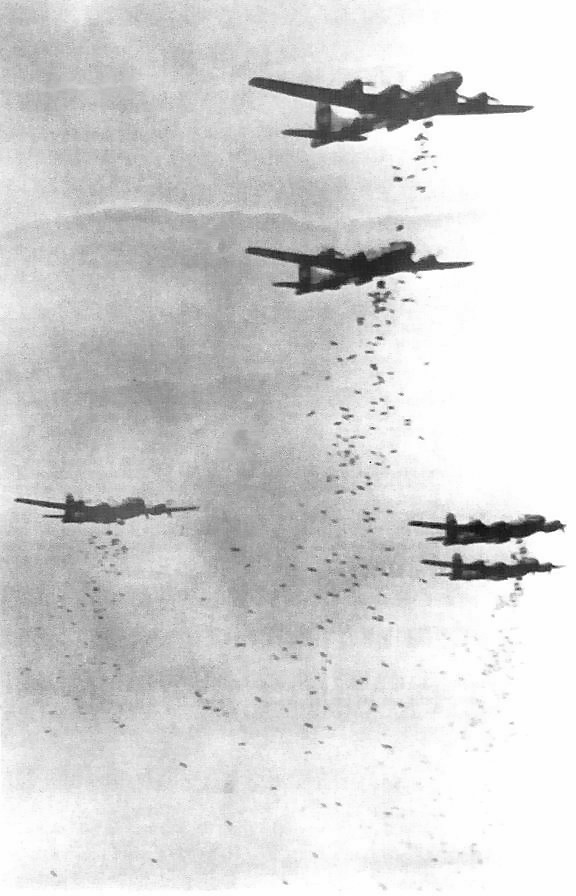
One of the officers in the USAAF bombing group in the European theater in July 1943 was Curtis LeMay, who in September 1943 was named head of the newly formed 3rd Air Division there. In August 1944, he was transferred to the Pacific Theater, where he soon emerged as head of all air operations against Japan’s home islands. In that capacity, he designed and led the area-wide firebombing of scores of Japanese cities, using the same tactics of counter-civilian, mass-scale incendiary bombings that he had seen (and admired) the British RAF using in Europe since 1943. He seems to have been confident enough to conduct some of those campaigns during day-time. And Japan’s wood-and-paper dwellings proved extremely easy to burn up wholesale.
Curtis LeMay’s firebombings of Japanese cities provided key context for how it seemed “okay” for Pres. truman and his advisors to use the two single atomic bombs to burn up the whole of Hiroshima and Nagasaki in early August 1945.
We should also be clear that for the RAF Bomber Command’s leader Sir Arthur (‘Bomber’) Harris and most of his officers, using airpower to intimidate and terrorize enemy populations, and not just to attack their military sites, had been quite a normal procedure for more than two decades prior to 1943. It was what the RAF routinely did during the numerous imperial campaigns they participated in, in Iraq, the Northwest Frontier, Somalia, and elsewhere. Such “rules of the road” as the British military recognized then that restricted what might be a “legitimate” military target still applied only to “enemies” that were “White”.
There was thus an almost straight line from the tactics the British imperial forces used against subject populations in the Global South, through Bomber Harris’s practices against enemy populations in Germany, to the idea that using nuclear weapons against entire populations of cities in Japan was quite okay, or possibly even laudable. That point was well made in Sven Lindqvist’s book A History of Bombing, which I urge everyone to read.
